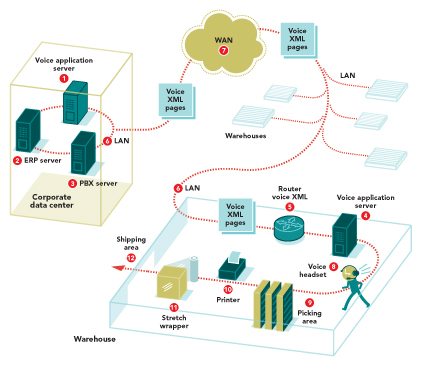How VoIP works at Coca-Cola
The system uses wide area and local area networks to direct operations on the floor of warehouses across the enterprise.
Latest Material Handling News
NetLogistik partners with Vuzix subsidiary Moviynt to offer mobility solutions for warehouses Lucas Watson appointed CSO for Körber’s Parcel Logistics business in North America Hyster recognizes Dealers of Distinction for 2023 Carolina Handling names Joe Perkins as COO Walmart deploying autonomous lift trucks at four of its high-tech DCs More NewsSeveral different components at the corporate and facility level come together to enable the VoIP voice recognition solution at Coca-Cola Refreshments U.S.A. (CCR).
The voice application (Datria) is hosted on a bank of servers (1) at the company’s corporate data center in Atlanta. That site also houses the company’s enterprise resource planning (ERP) software system (2) and the private branch exchange (3), or PBX, which is the telephone exchange that serves Coca-Cola’s internal telephones and connects to an external public network.
A second server (4) located in each of the 100 facilities using the voice system hosts the speech recognition text-to-speech application. This is the application that translates a VoiceXML page created by the voice application into voice instructions for workers. Each facility also has a router (5) that acts as a browser for the VoiceXML pages. Finally, communication takes place within both the corporate data center and the facilities over the wireless local area network (LAN) (6). Communication between the corporate data center and the facilities takes place over a corporate wide area network (WAN) (7).
That’s the basic voice infrastructure. Here’s how the components all come together to fulfill orders.
In the corporate data center, orders are passed back and forth between the ERP system and the voice application to create an order in a VoiceXML page format. The VoiceXML pages are routed by the PBX system from the LAN at the data center to the WAN and then to the LAN at the appropriate facilities to fill the orders. Once they are received at the facility, they are routed over the wireless LAN to the speech technologies server, where they are turned into voice instructions.
Prior to voice, an order selector would log into a kiosk in the warehouse by swiping a card. The system would then print out a paper pick list. Today, the order selector begins the shift by selecting a VoIP telephone and headset (8). Each phone has an IP address. When the worker logs on, a telephone connection is established with the local server. He will also use the speed dial function to choose to receive instructions in English, Spanish or French. At that point, he will be asked by the system for his ID. Based on the order selector’s profile, the system will give the order selector the next order to be picked. From the time the selector dials into the system, he will be connected in one continuous call unless he goes on break, goes to lunch or clocks out.
The selector is then directed by voice to a slot location for picking (9). The selectors use man aboard pallet jacks and pick to a pallet. Once the selector arrives at a location, he is asked to speak the slot number and a check digit into the headset; when the digit is confirmed, the system tells him what quantity and what product should be picked.
At the last pick for an order, the system will prompt the selector to go to a printer (10), where he will get a pallet ticket or a pallet label. The selector speaks the last three digits of the pallet ID number to confirm that he has the correct label. After confirmation, he will stretchwrap (11) and stage the pallet for delivery (12).
If the order selector wants to ask a specific question, he will be presented with a menu of options. If there is no material available for picking at a slot location, for instance, the order selector can short the order by speaking a reason code. If a selector is uncertain about the product to be picked, he can ask for a product description–CCR has recorded a wave file for each brand and each product. In addition, a selector can ask the system for the largest quantity to be picked first to build the most stable pallet.
Once the order selector completes and verifies the pick, the system repeats the process until the order is complete.

System suppliers
Voice recognition technology: Datria
ERP: SAP
Voice mobile devices: Cisco
Electric pallet jacks: Cat Lift Trucks
Coke’s new take on voice technology
To revitalize its distribution processes, Coca-Cola Refreshments U.S.A. implemented a VoIP-based voice technology that enables 3,000 warehouse associates in 100 facilities.
VoIP or traditional voice: Which solution is better?
Which voice technology solution is right for your facility?

Article Topics
Latest in Materials Handling
NetLogistik partners with Vuzix subsidiary Moviynt to offer mobility solutions for warehouses Materials Handling Robotics: The new world of heterogeneous robotic integration Lucas Watson appointed CSO for Körber’s Parcel Logistics business in North America Hyster recognizes Dealers of Distinction for 2023 Carolina Handling names Joe Perkins as COO C-suite Interview with Keith Moore, CEO, AutoScheduler.AI: MODEX was a meeting place for innovation Walmart deploying autonomous lift trucks at four of its high-tech DCs More Materials HandlingAbout the Author
Subscribe to Materials Handling Magazine

Find out what the world's most innovative companies are doing to improve productivity in their plants and distribution centers.
Start your FREE subscription today.
April 2024 Modern Materials Handling

Latest Resources










